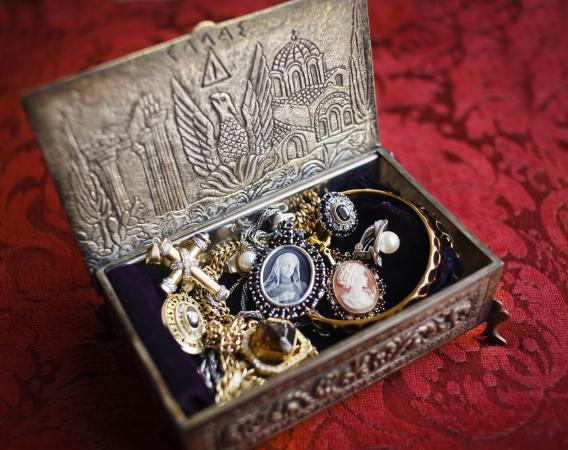The end of the Victorian era saw much change as technology advanced, and modern conveniences had a liberating effect. With the introduction of electric light, going out for evening activities was not such a dark experience. This freedom affected many things, including jewellery.
It is in the Aesthetic Period that jewellers began to prioritise the beauty of ornamentation over symbolism. Art for art’s sake. The symbolism did not vanish, it never has, but it was no longer more important than the beauty of the art.

- Casting Off The Burden: The Grand Period (1861) was a time of mourning for the death of Prince Albert. By 1885, the artisans felt it was time to move on. The dense constructions of the Grand Period began to give way to more delicate pieces. In the Aesthetics period, jewellery began to include negative space and organic shapes. Cut gems in clusters and flowery, delicate forms, reflected the optimism, prosperity, and changing social roles of the period. If you want to have a glimpse of antique jewellers Sydney collectors see at Kalmar Antiques, the dealer keeps its website updated so you would see the latest offers just as if you were looking at the pieces in person. If you live elsewhere, searching on Google for dealers near you would be the best thing to do.
- Liberation: The final stage of the Victorian era was a time of challenging traditional ideas. The Aesthetic period gets its name from the philosophical explorations of the day. The middle class was rising, and women were becoming involved with politics, science, and sports. Lighter, more joyful designs became popular. And despite advanced machinery for mass production, hand-crafted designs found a resurgence. The heavy machine-stamped images of the grand period came to be seen as dreary and moribund.
- Symbolism: Although the interest in Etruscan and Egyptian symbolism continued into the Aesthetic Period, many designers began to explore new themes. Oriental influences can be seen and there are also iconic details in many pieces – knots, leaves, and stars, among others. The jewellery took on natural organic forms and an exploration of shapes. Concurrently Darwin’s exciting discoveries brought new interest in flora and fauna and the designs of nature.
- Materials: The Aesthetic period benefitted from an increase in silver production in the United States. Silver became a popular, lighter background for the gems to shine in the electric light. Gold, rolled gold, and platinum remained popular as well. Popular gems were mine cut diamonds, peridot, rubies, opals, chrysoberyl, and emeralds.
- Styles: The Aesthetic period saw some innovation in design and wearability. Hinged tube catches and safety chains for broaches began to appear. There were new variations in earring designs, including screw clasps for unpierced ears. Overall, the designs were delicate and airy. Fine chains and dangling ornaments, delicate insect broaches and gems, and elegant yet light chokers and tiaras came out at night to celebrate the newly discovered nightlife.
The Aesthetic period was a time of awakening and a time of appreciation. Some might also say the beginning of humanism. It was a time for casting off the stuffy Victorian ideals. It was an optimistic leap towards better things to come. Beauty was seen in natural things and there were more minimal graceful designs. The jewellery of this period reflects the positivity at the dawn of the 20th century.
- 10 Best Yoga Asanas for Beginners
- DIY- Mayonnaise Banana Hair Pack for Beautiful Hair
- The New Generation’s New Rules of Prom
- Fashion Accessories for Men: Latest Trends!
- Does a Man Need to Wear the Engagement Ring
- Types of Panties Know the Different Types Styles of Panties
- 5 Beauty Habits You Should Stay Away From
- Benefits and Uses of Essential Oils
- Easy Remedies to Cure Open Pores






Gorgeous antiques. So unique to find nowadays!!!
http://www.fashionradi.com
Very beautiful period, so unique. Have a nice day!
https://chicchedimamma.com/
Such an informative post. Thanks for sharing with us.
https://www.ninakobi.com
Very interesting, some great insights into Victorian jewellery, thank you 🙂
Such an interesting post! Loved finding out more about this period in jewellery
Julia x
https://www.thevelvetrunway.com/
Thanks for sharing this time period! The jewels looks amazing.
https://www.kathrineeldridge.com
Very interesting 😊!!!